The Indian car market is on the verge of a big change. The government has announced a 5% GST rate for fuel-cell cars, starting September 22, 2025. This move puts hydrogen vehicles on the same level as petrol and diesel cars, changing the game.
Five key fuel-cell vehicles are set to hit the Indian market. Thanks to the lower GST rate, these cars will be more affordable for people looking for green options. This is a big win for those wanting to switch from traditional engines.
Now is the perfect time for this change. Global car makers are adding more fuel-cell models to their lines. With the 5% GST, fuel-cell cars in India can compete with traditional cars on price. This move shows India’s dedication to hydrogen technology in the car industry.
Key Takeaways
- India reduces GST on fuel-cell vehicles to 5%, matching rates for petrol and diesel cars
- Five hydrogen vehicles are prime candidates to launch in India following the tax benefit
- The policy takes effect September 22, 2025, making FCVs more affordable for buyers
- Fuel-cell cars now enjoy equal tax treatment with conventional vehicles for the first time
- Major automakers are preparing to introduce hydrogen models to capitalize on the incentive
- The GST reduction could accelerate India’s shift toward zero-emission transportation
Understanding Fuel-Cell Technology
Fuel-cell technology is a big step forward in cars, making them cleaner and more efficient. In India, people are looking for better ways to travel than old gas engines. FCVs are a top choice because they use hydrogen to make electricity, leading the way in green cars.
What Are Fuel-Cell Vehicles (FCVs)?
FCVs run on hydrogen fuel cells, making electricity from hydrogen and oxygen. They don’t burn gas like regular cars, so they only make water vapor and heat. This means no big batteries are needed, unlike electric cars.
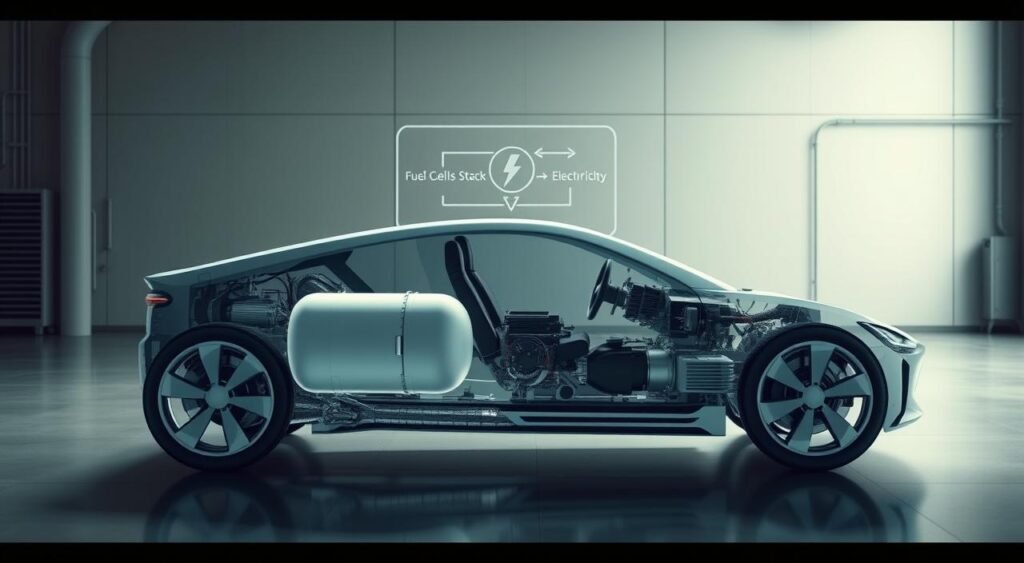
How Do Fuel Cells Work?
Fuel cells work by breaking down hydrogen into protons and electrons. The electrons make electricity for the car’s motor. Oxygen and the protons make water vapor, the only thing these cars emit.
Key Benefits of Fuel-Cell Technology
Hydrogen cars have many good points:
- Rapid refueling: Fill up in just 3-5 minutes, like gas cars
- Extended range: Go 400-600 kilometers on one tank
- Zero emissions: Only make water vapor
- Energy efficiency: Use 60% of fuel energy for power
- Quiet operation: Make very little noise
| Feature | FCVs | Traditional Vehicles |
|---|---|---|
| Refueling Time | 3-5 minutes | 5-7 minutes |
| Emissions | Water vapor only | CO2, NOx, particulates |
| Energy Efficiency | 60% | 20-35% |
| Range per Tank | 400-600 km | 500-800 km |
The Current State of Fuel-Cell Cars in India
The Indian car market is changing, moving from old engines to new, cleaner ones. Electric cars are getting popular, but fuel-cell cars are also gaining attention. The car industry in India, worth over $100 billion, is looking into hydrogen cars as a green option.
Overview of the Indian Automobile Market
India has a huge car market, with over 3.8 million cars sold every year. Big names like Toyota, Hyundai, and Tata Motors lead the market. Toyota, for example, has 12 models, but no fuel-cell cars yet.
People are starting to want cleaner cars because of pollution and bad air in cities. This interest could help fuel-cell cars become more common in India.

Government Policies Supporting FCVs
The government is backing hydrogen cars with new rules. They want to make fuel-cell cars cheaper to buy. In 2022, the government started a program with Toyota to test hydrogen cars.
Some key policies include:
- A new plan to make more green hydrogen
- Help for companies making fuel-cell cars
- Money for building hydrogen stations
- Tests in some cities to see how well they work
Challenges Facing FCV Adoption in India
Fuel-cell cars in India face big challenges. The biggest one is the lack of places to fill up with hydrogen. Hydrogen stations need special equipment and safety measures.
Other problems are the high cost of these cars, not many people know about them, and electric cars are also popular. The car industry, government, and others need to work together to make hydrogen cars a reality in India.
Financial Implications of GST on Fuel-Cell Vehicles
The introduction of a 5% GST rate for fuel-cell vehicles is a big deal for India’s car market. This lower tax makes these eco-friendly cars more affordable than regular cars. It means buyers can get advanced hydrogen technology at a better price.
What is GST and How Does It Work?
Goods and Services Tax (GST) is India’s single tax system that replaced old taxes. For cars, GST rates change based on the car’s type and features. Most cars face a GST rate between 18% and 28%, with extra taxes making it even higher.
The 5% GST for fuel-cell vehicles is the lowest tax for cars in India. This lower tax is a big help for these cars, which are good for the environment. It encourages more people to buy them.
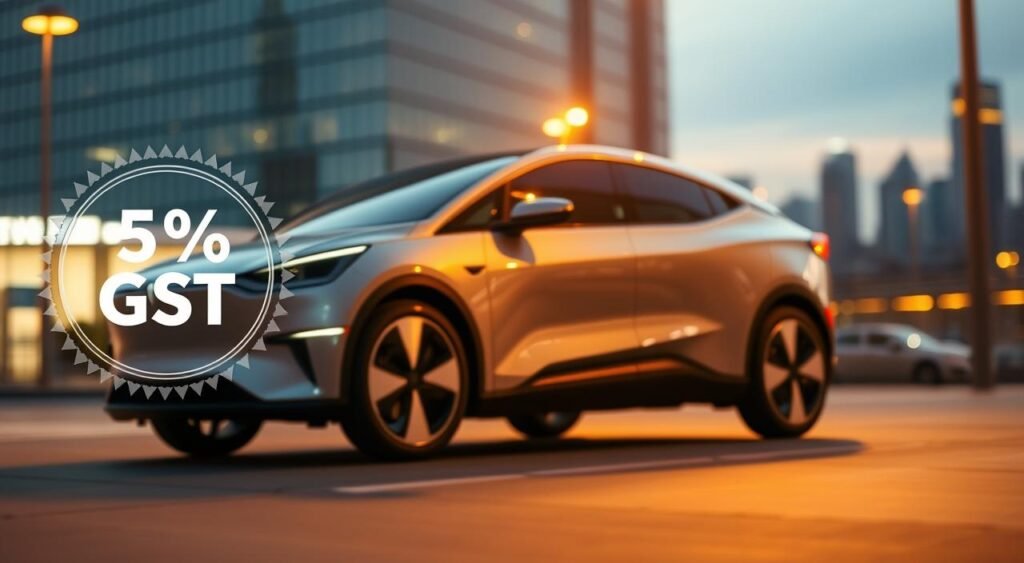
Impact of 5% GST on FCV Pricing
The lower GST rate saves a lot of money for buyers. For example, a fuel-cell car priced at Rs. 60 lakh gets a GST of just Rs. 3 lakh. This is much less than the taxes on regular luxury cars.
Comparisons with Other Vehicle Categories
| Vehicle Category | GST Rate | Additional Cess | Total Tax Impact |
|---|---|---|---|
| Fuel-Cell Vehicles | 5% | 0% | 5% |
| Electric Vehicles | 5% | 0% | 5% |
| Petrol/Diesel Cars | 28% | 1-20% | 29-48% |
| Hybrid Vehicles | 28% | 15% | 43% |
Fuel-cell vehicles now have the same tax benefits as electric vehicles. This makes them the most affordable eco-friendly cars to buy. They also get extra state incentives and lower fees in many places.
Five Fuel-Cell Vehicles Emerging in India
India’s car market is changing fast. Big names are getting ready to bring hydrogen cars to the roads. These cars use new tech that could change how we travel. Let’s look at the top FCVs that might get cheaper soon.
Toyota Mirai: A Trailblazer in FCVs
The Toyota Mirai is a leader in hydrogen cars worldwide. It’s a sleek sedan with over 180 PS power. It can go 600-650 kilometers on one tank, making long trips easy.
What’s cool about the Mirai is how fast it refuels. Just five minutes to fill up. It’s been improved over the years, making it even better.
Hyundai Nexo: An Innovative Approach
Hyundai’s Nexo is a mid-size SUV, like the Tucson. It goes over 700 kilometers on a single tank. It also refuels quickly, in just five minutes.
This SUV is great for families. It’s big and has the latest fuel-cell tech. It’s a top choice for those wanting a big, green car.
Honda Clarity: Features and Benefits
Honda’s CR-V FCEV is different. It has a hydrogen fuel cell and a 17.7 kWh battery. This combo gives it a 450-kilometer range.
It’s special because you can use electric power too. This makes it very versatile, unlike most FCVs.
Tata Motors’ Future Projections
While big brands lead, Tata Motors is also working on hydrogen cars. They see the value of fuel cells for India. They’re making cars that fit India’s needs and infrastructure.
How 5% GST Could Boost FCV Sales
The introduction of a 5% GST rate for fuel-cell cars in India is a big deal. It makes fuel-cell cars more affordable for both makers and buyers. This could change the game for clean energy vehicles in the market.
Potential for Increased Adoption Rates
The 5% GST rate lowers the cost of fuel-cell cars in India. This makes them more appealing to a wider range of people. Electric vehicles, on the other hand, face GST rates between 12% to 28%.
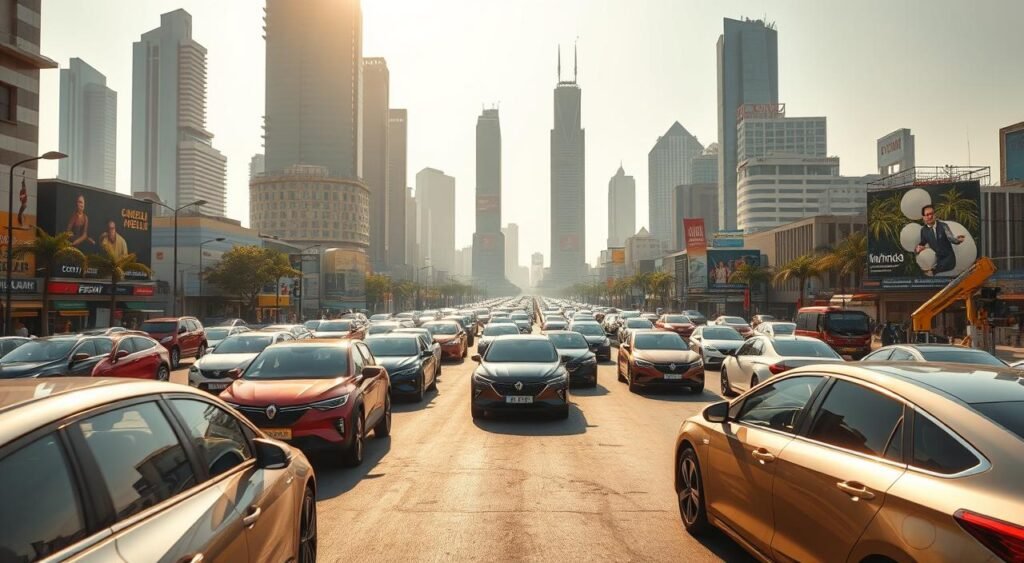
Lower taxes could lead to a 30-40% increase in FCV adoption in the first two years. Fleet operators and corporate buyers are interested in FCVs. They like the quick refueling and longer driving ranges compared to electric cars.
Encouragement for Manufacturers and Investors
The reduced GST rate shows India’s commitment to hydrogen technology. Big names like Toyota and Hyundai are thinking about bringing their hydrogen models to India. The tax benefits make it easier to produce and sell these cars locally, attracting more investment.
Consumer Awareness and Education
For FCVs to succeed, people need to understand their benefits. Zero tailpipe emissions, fast refueling, and long driving ranges are key. Industry groups and the government are working on campaigns to spread the word about these advantages and the 5% GST rate.
Environmental Impact of Fuel-Cell Vehicles
Fuel-cell vehicles are a big step forward in clean energy cars. They help India move towards a greener future. Unlike gas cars, FCVs only release water vapor, not harmful pollutants.
This is great news for India’s air quality and its environmental goals.
Reducing Carbon Emissions
Fuel-cell vehicles don’t have tailpipe emissions, making them eco-friendly cars. Each FCV can cut down about 4.6 metric tons of CO2 a year. This is a big deal for cities like Delhi and Mumbai, which are really struggling with air pollution.
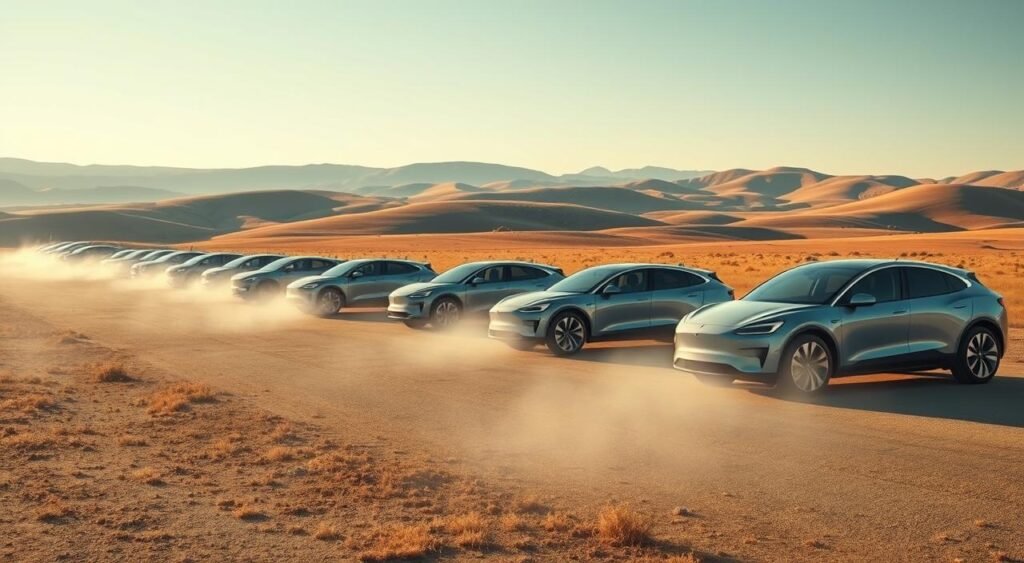
The Role of Renewable Energy in FCVs
The good news about green vehicles goes beyond zero emissions. If hydrogen is made from solar or wind power, FCVs are totally carbon-neutral. India’s growing solar farms in places like Rajasthan and Gujarat are perfect for making clean hydrogen.
Long-term Sustainability Benefits
FCVs have big advantages over electric cars in how they affect the environment. They don’t have the lithium mining and battery disposal issues. They also need fewer rare earth materials and last longer.
As India builds its hydrogen network, these clean energy cars will be key to reaching its 2070 net-zero emissions goal.
FCVs vs. Battery Electric Vehicles (BEVs)
The Indian car market is at a turning point. It’s between fuel-cell vehicles and battery electric vehicles. Each has its own benefits for those who care about the environment. Knowing the differences helps people choose the right car for them.
Comparing Performance and Efficiency
Fuel-cell vehicles are quick to refuel, taking only 3-5 minutes. This is much faster than charging electric cars, which can take hours. They also have a long range, up to 820 kilometers per tank, beating many electric cars.
Battery electric vehicles are better at using energy, turning 77% of it into power. Fuel-cell cars are about 60% efficient. Both types don’t emit any pollution, making them good choices for clean energy.
Cost Considerations and Long-term Value
There’s a big price difference at the start:
| Vehicle Type | Average Price Range (INR) | Fuel Cost per 100km | Maintenance Frequency |
|---|---|---|---|
| Fuel-Cell Vehicles | 50-65 lakhs | ₹400-500 | Every 10,000 km |
| Battery Electric Vehicles | 15-35 lakhs | ₹80-150 | Every 15,000 km |
BEVs are cheaper to run, which appeals to those watching their budget. Fuel-cell cars need less battery replacement, which could save money in the long run, even if they cost more upfront.
Infrastructure Needs for Both Technologies
Building more charging stations is key for both types. India had over 1 million EV charging points by 2019. But, hydrogen cars have fewer places to refuel.
Setting up hydrogen stations is expensive, costing ₹15-20 crores each. EV charging is easier to expand, with many people able to charge at home. Both need more stations to become more popular in India.
The Role of Government in Promoting FCVs
The government is key in shaping the future of fuel-cell cars in India. They are making policies and partnerships to help hydrogen cars grow. The 5% GST rate is a big step towards making cars more affordable and sustainable.
Incentives for Consumers and Businesses
The Indian car industry is getting a lot of support from the government. The 5% GST rate makes fuel-cell cars cheaper than regular cars. This can save people around ₹5-10 lakhs on high-end FCVs.
- Direct purchase subsidies under the FAME scheme
- Tax deductions for businesses adopting hydrogen fleets
- Reduced road tax and registration fees in select states
- Priority parking and toll exemptions for FCV owners
Collaborations with Automotive Manufacturers
Partnerships between the government and car makers are speeding up FCV development. The 2022 pilot program with Union Minister Nitin Gadkari testing the Toyota Mirai was a big moment. These partnerships include research and technology sharing with Toyota and Hyundai.
Future Policy Directions
The future plans include building more hydrogen stations and growing the market. They aim to have 100 stations by 2030 in big cities. The goal is to use green hydrogen made from renewable energy, making cars run on clean energy.
Policy frameworks are being drafted to standardize hydrogen fuel quality and safety protocols, creating a strong ecosystem for the industry’s future.
Public Perception and Acceptance of FCVs
In India, understanding hydrogen vehicles is a big challenge. Many people don’t know how FCVs work or their benefits. We need to clearly explain how they work and address concerns to gain trust.
Common Misconceptions About Fuel-Cell Technology
Many myths about FCVs slow their adoption. Some think they’re dangerous because of fuel storage. But, modern hydrogen tanks are tested and safe.
Another myth is that they can’t go far. The Toyota Mirai can go over 400 miles on one tank, just like gas cars. High costs are also a worry. But, running them is cheaper, and refueling is quick.
Japan and South Korea have shown FCVs are reliable. But, many in India don’t know this.
Educational Initiatives for Consumers
Car makers and governments are working to teach people about FCVs. They offer test drives and share info online. They also train dealers and service centers.
Success Stories from Early Adopters
The 2022 Toyota Mirai pilot in New Delhi was a success. Fleet operators were happy with the cars’ performance. Programs in California and Germany offer lessons for India.
Companies using hydrogen vehicles save money and help the environment. This encourages more people to accept them.
The Future of Fuel-Cell Cars in India
India is at a turning point with fuel-cell cars set to change its car scene. A 5% GST cut opens doors for eco-friendly cars to enter the market. Big names like Toyota and Hyundai are getting ready to launch their fuel-cell models. Tata Motors, a local company, is also diving into this exciting tech.
But, there’s a lot of work ahead. We need to plan well and invest in hydrogen infrastructure.
Predictions for Market Growth
Experts think fuel-cell cars in India will grow slowly but surely over the next ten years. The Toyota Mirai and Hyundai Nexo are set to be the first ones on the market. BMW’s iX5 Hydrogen and Honda’s CR-V FCEV are also waiting for the right time to come out.
They predict that by 2030, hydrogen cars could grab 2-3% of the premium car market. This will happen if we have more hydrogen stations and teach people about fuel-cell tech.
Technological Advances on the Horizon
New tech in fuel cells promises better efficiency and lower costs. Engineers are working on better hydrogen storage and using less platinum in fuel cells. The Toyota Crown shows off advanced fuel-cell tech that might come to India.
Improvements in battery tech are also helping fuel cells. They’re making hybrid systems that use both power sources. These changes make eco-friendly cars more suitable for Indian roads and driving habits.
Closing Thoughts on the Importance of FCVs in India
Fuel-cell vehicles are key for India’s clean transport future. The GST cut shows the government’s support for green vehicles, not just battery electric ones. Success needs teamwork between car makers, energy firms, and government to build hydrogen stations.
The path to making fuel-cell cars common in India is long. But, the steps we take today will shape tomorrow’s transport. As India seeks energy freedom and cleaner air, fuel-cell cars are a vital option that deserves our support.

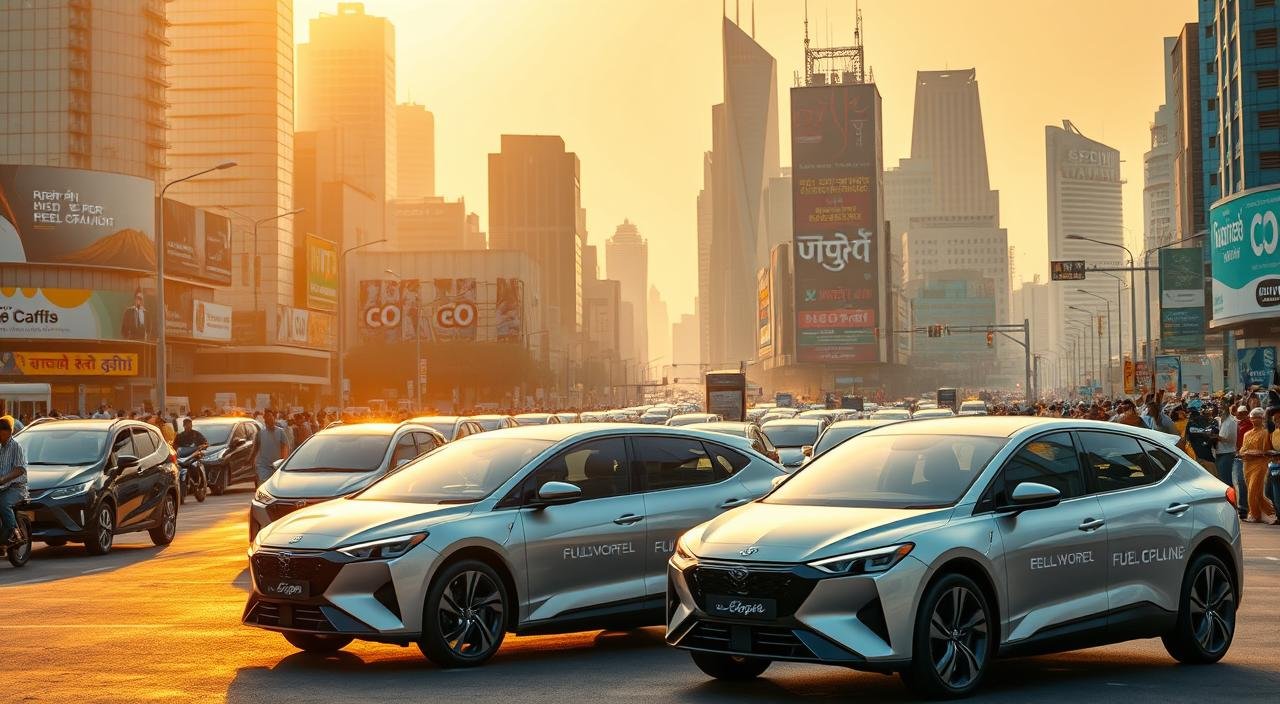


Leave a Reply